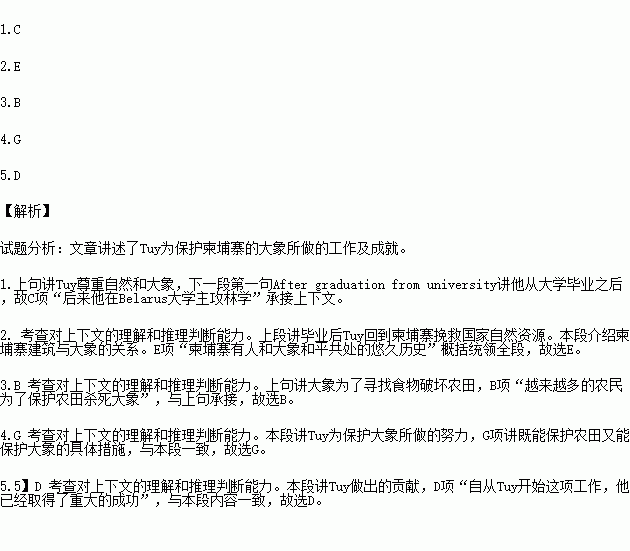题目内容
Tuy Sereivathana was born in 1970. In 1975 his family fled from the city to rural village where Tuy’s parents, both well-educated, taught school in the mornings to the local children and farmed in the afternoons to make ends meet.During his childhood, Tuy developed a deep respect for nature and elephants. ___1.____
After graduation from university, he returned to Cambodia to save his country’s natural resources. ____2.__ Its most famous building, the Angkor Wat temple, was built out of stone with the help of elephants.However, with their habitat decreasing, elephants were destroying farms as they looked for food.__3.__
As a ranger(国家公园管理员) in Cambodia’s national parks, Tuy worked throughout the country, connecting with rural communities and learning more about elephant migration and ecosystem.In Prey Proseth and Trang Troyeng, there lived 30,000 people on the forest’s edge, where he was aware of the lack of capacity within these communities to manage the human-elephant conflict._4.__ More importantly, he taught the farmers to work together, encouraging them to organize overnight guard groups to protect the fields.Tuy also informed the communities of the national and religious pride attached to the elephants.
___5.__ As a result of Tuy’s involvement with the project, there wasn’t a single confirmed elephant death due to human-elephant conflict since 2005.
A.The elephant there are in danger of dying out.
B.More and more farmers had to kill them to protect their crops.
C.Later, he majored in forestry in Belarus University.
D.Since his work began, Tuy has been a significant success.
E.Cambodia has a long history of peaceful coexistence between people and elephants.
F.Now the villagers have begun to realize the importance of protecting animals.
G.Tuy began to teach villagers how to use fences, fireworks and fog horns to keep off elephants.
 阅读快车系列答案
阅读快车系列答案
